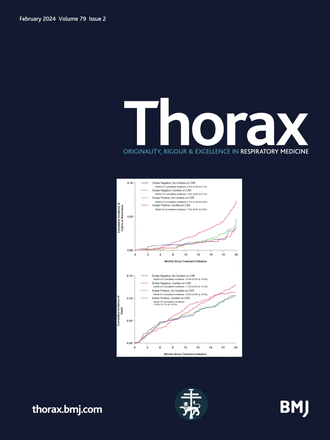Real-world telemonitoring and remote support for home non-invasive ventilation to improve therapy effectiveness: the exploratory, multicentre randomised eVENT study
IF 9
1区 医学
Q1 RESPIRATORY SYSTEM
引用次数: 0
Abstract
Rationale Telemonitoring has shown benefits during the initiation of home non-invasive ventilation (NIV) but evidence is lacking regarding its use during follow-up. A French national telemonitoring programme incorporating remote support and therapeutic education is designed to improve patient pathways and reduce healthcare resource utilisation. This study investigated the impact of the telemonitoring programme versus usual follow-up on the effectiveness of home NIV. Methods The prospective, multicentre, open-label eVENT trial enrolled adults recently started on home NIV. Participants were randomised to the telemonitoring or usual follow-up group. In the telemonitoring group, a CE-marked algorithm generated alerts based on teletransmitted ventilator data. Specialised nurses managed alerts and provided therapeutic education. The primary outcome was mean nocturnal transcutaneous carbon dioxide level (PtCO2) on NIV after 6 months. Results 56 patients were randomised and 53 were analysed (telemonitoring: n=27, usual follow-up: n=26). At 6 months, mean PtCO2 did not differ significantly between the telemonitoring and usual follow-up groups (42.1±6.1 vs 43.9±6.4 mm Hg; p=0.352) but mean room air partial arterial carbon dioxide pressure (PaCO2) was significantly lower in the telemonitoring versus usual follow-up group (41.7±6.8 vs 46.2±3.5 mm Hg; p=0.003). The proportion of participants without diurnal or nocturnal hypercapnia at 6 months was 82.6% with telemonitoring and 27.3% with usual follow-up (p<0.001). Compared with usual follow-up, the telemonitoring group had greater NIV use, more days with NIV usage ≥4 hour and less non-intentional leaks. Conclusions In patients on home NIV, PtCO2 was similar with telemonitoring and usual follow-up, but PaCO2 levels and the quality of ventilatory support were significantly better with telemonitoring. Trial registration number [NCT04615078][1]. No data are available. The data are not publicly available due to privacy or ethical restrictions. [1]: /lookup/external-ref?link_type=CLINTRIALGOV&access_num=NCT04615078&atom=%2Fthoraxjnl%2Fearly%2F2025%2F04%2F01%2Fthorax-2024-222033.atom现实世界远程监测和远程支持家庭无创通气提高治疗效果:探索性,多中心随机事件研究
理论依据 远程监护在家庭无创通气(NIV)的初始阶段已显示出其优势,但在后续阶段的使用方面却缺乏证据。法国的一项全国性远程监护计划结合了远程支持和治疗教育,旨在改善患者的治疗路径并减少医疗资源的使用。本研究调查了远程监控计划与常规随访对家庭 NIV 效果的影响。方法 前瞻性、多中心、开放标签的 eVENT 试验招募了最近开始使用家庭 NIV 的成年人。参与者被随机分配到远程监控组或常规随访组。在远程监护组,一种经 CE 认证的算法会根据远程传输的呼吸机数据生成警报。专业护士负责管理警报并提供治疗教育。主要结果是 6 个月后 NIV 的平均夜间经皮二氧化碳水平 (PtCO2)。结果 56 名患者被随机选中,53 名患者接受了分析(远程监控:27 人,常规随访:26 人)。6 个月后,远程监测组和常规随访组的平均 PtCO2 没有明显差异(42.1±6.1 vs 43.9±6.4 mm Hg;p=0.352),但远程监测组的平均室内空气动脉二氧化碳分压(PaCO2)明显低于常规随访组(41.7±6.8 vs 46.2±3.5 mm Hg;p=0.003)。在 6 个月时,没有出现昼间或夜间高碳酸血症的参与者比例在远程监控组为 82.6%,在常规随访组为 27.3%(P<0.001)。与常规随访相比,远程监控组的 NIV 使用率更高,NIV 使用时间≥4 小时的天数更多,非有意泄漏更少。结论 在使用家庭 NIV 的患者中,远程监测组和常规随访组的 PtCO2 相似,但远程监测组的 PaCO2 水平和通气支持质量明显更好。试验注册号 [NCT04615078][1]。无数据。由于隐私或伦理限制,数据未公开。[1]:/lookup/external-ref?link_type=CLINTRIALGOV&access_num=NCT04615078&atom=%2Fthoraxjnl%2Fearly%2F2025%2F04%2F01%2Fthorax-2024-222033.atom
本文章由计算机程序翻译,如有差异,请以英文原文为准。
求助全文
约1分钟内获得全文
求助全文
来源期刊

Thorax
医学-呼吸系统
CiteScore
16.10
自引率
2.00%
发文量
197
审稿时长
1 months
期刊介绍:
Thorax stands as one of the premier respiratory medicine journals globally, featuring clinical and experimental research articles spanning respiratory medicine, pediatrics, immunology, pharmacology, pathology, and surgery. The journal's mission is to publish noteworthy advancements in scientific understanding that are poised to influence clinical practice significantly. This encompasses articles delving into basic and translational mechanisms applicable to clinical material, covering areas such as cell and molecular biology, genetics, epidemiology, and immunology.
 求助内容:
求助内容: 应助结果提醒方式:
应助结果提醒方式:


